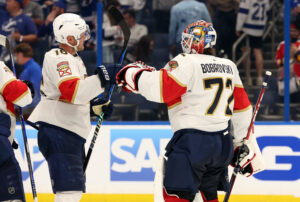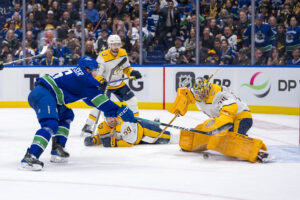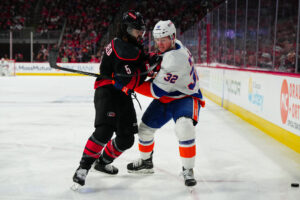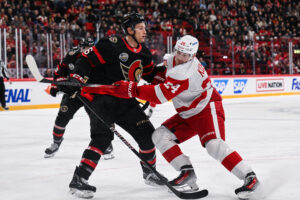In part one of our four-part series on the broken systems around NHL Playoff Officiating and player safety, we covered a series of head hits and the many layers of failure. In part two, we’ll cover a key play in the opening round of the playoffs and, once again, see a system that fails badly.
Part 2: NHL Playoff Officiating, Player Safety and a Failure of Accountability
We’ll start here. Imagine it is your kid playing a sport and you notice players on the other team have, in the past few minutes, deliberately elbowed your kid in the head, deliberately tried to trip your kid, deliberately smacked your kid in the chest, deliberately hit your kid in the groin and deliberately sucker-punched your kid in the face. The next thing which happens is your kid is knocked to the ground by an opposing player and is unconscious and bleeding. Do you assume this last event is an accident?
The Joe Pavelski Injury
With 10:47 seconds left to go in Game 7 of the series between the Vegas Golden Knights and San Jose Sharks, the game was stopped. Sharks winger Joe Pavelski had just taken a face-off, been cross-checked in the chest by the Golden Knights Cody Eakin and thrown to the ice by Eakin’s teammate Paul Stastny.
Pavelski was knocked unconscious as a result; he lay bleeding on the ice before trainers and teammates helped him from the ice. During the television timeout, members of the venue’s ice maintenance crew attempted to scrape away the blood. Despite their efforts, the ice remained stained.
Pavelski needed staples in his head to close the wound, suffered a concussion and required surgery on his hand. In total, he’d miss 15 days and six playoff games before he was healthy enough to play again.
It was a big deal.
NHL Ecosystem Reactions
There were plenty of reactions to this play, but one seemed conspicuously absent. When a player is this severely hurt, the NHL owes it to everyone, especially themselves, to do a careful review. They should know how it happened and determine how it gets prevented in the future. It has an obligation to the players in the league, the officials, the media and beyond. Failure to do so has ramifications that are harmful to the league and all the various stakeholders.
The league, as best as I can tell, has failed completely on this front. Is it incompetence, laziness, cowardice or something more cynical?
The NHL company line portrayed this as an ‘accident’, nothing was done deliberately here. The mainstream NHL media, incompetently, lazily and perhaps cowardly, sucked up the company line.
Before the Play
Let’s begin the digging.
By reviewing the game in the minutes before the Stastny throwdown, one could test the party line that there was no deliberate attempt to hurt Pavelski. It required just the shift Pavelski was injured on and the one before it to get a definitive answer. There is overwhelming evidence the Golden Knights were indeed, trying to hurt Pavelski. Video of the plays described below is available, courtesy of NBC Sports California. All the cropped screen captures below are from this game video.
Want to thank NBC Sports California for providing me the video and it is used here with their permission. We'll be looking at elements of this video for tomorrow's article on player safety and officiating. pic.twitter.com/8QaxEzlxCP
— ZEKE and MO (@ZEKEandMO) July 23, 2019
The Mark Stone Hit
With 12:51 remaining, Mark Stone hit Pavelski into the boards with what began as a clean shoulder-to-shoulder hit. But Stone decided he also needed to drive his elbow into Pavelski’s head (note, this is hard to see watching the game video, but at least one replay captures it clearly). Was Stone’s elbow to the head deliberate? Of course, it was. He started with a clean hit, then decided to add something extra to it. Pavelski’s shift ended shortly thereafter.
 Mark Stone elbows Joe Pavelski in the head (courtesy of NBC Sports California)
Mark Stone elbows Joe Pavelski in the head (courtesy of NBC Sports California)
Stastny and Pavelski, Five Seconds
 Paul Stastny (26) places his stick around the ankle of Joe Pavelski (8) (courtesy of NBC Sports California)
Paul Stastny (26) places his stick around the ankle of Joe Pavelski (8) (courtesy of NBC Sports California)
Pavelski’s next shift began with a bit over 11 minutes left. A whistle stopped play with 10:59 left. With 10:59 left, Paul Stastny and Pavelski stepped into the face-off circle. Following the puck drop, Stastny hooked Pavelski’s left ankle with his stick and lifted Pavelski’s leg a few feet off the ice in an attempt to trip him. Another deliberate move.
 After putting his stick around Pavelski’s ankle, Stastny lifts upward in an attempt to trip Pavelski (courtesy of NBC Sports California)
After putting his stick around Pavelski’s ankle, Stastny lifts upward in an attempt to trip Pavelski (courtesy of NBC Sports California)
Pavelski kept his balance, spun out and headed to the net. At which point Stastny put his stick between Pavelski’s leg and jammed it into Pavelski’s groin area. Again, deliberate.
 Stastny’s stick goes between Pavelski’s legs (courtesy of NBC Sports California)
Stastny’s stick goes between Pavelski’s legs (courtesy of NBC Sports California)
But Stastny wasn’t through. With the stick still between Pavelski’s leg, Stastny sucker-punched Pavelski in the face. Again, deliberate.
 Stastny’s left hand punches Pavelski in the head (courtesy of NBC Sports California)
Stastny’s left hand punches Pavelski in the head (courtesy of NBC Sports California)
One can see Pavelski’s head snapped back by the punch. The entire sequence happens in five seconds, with play starting at 10:59 remaining and ending at 10:54 remaining.
 Pavelski’s head snaps back after the punch from Stastny (courtesy of NBC Sports California)
Pavelski’s head snaps back after the punch from Stastny (courtesy of NBC Sports California)
Did Stastny know he was walking a fine line with his play? There’s a moment which is telling. The whistle blew as Vegas goalie Marc-Andre Fleury made a save. Every skater on the ice looks in the direction of the play, except Stastny. He spins around and looks right at the official.
Play resumed with a face-off between Pavelski and Cody Eakin. Immediately after Pavelski won the draw, Eakin deliberately cross-checked Pavelski in the chest. This is the Golden Knights fifth documented attempt to hurt Pavelski in two shifts.
Injury and Hurt
We’ll scrutinize what happens in a moment, but take a moment to address one issue before continuing. Some will argue, with merit, there is a difference between ‘hurt’ and ‘injury’. A deliberate attempt to hurt a player is sometimes within the NHL cultural norms – even if it occurs outside the rules. An attempt to injure a player is outside norms (which NHL rule 21.1 makes clear). The line between hurt and injury is, at best, tricky to define. It is the players’ responsibility (individually and collectively) to stay on the acceptable side of this line. Officials can only judge the result.
The sixth event in the sequence was Stastny throwing Pavelski to the ice, resulting in the injuries described earlier. The line between hurt and injury was crossed.
Going back to the original point, where was the investigation? We’re all being asked to believe after five deliberate attempts to hurt Pavelski over just two shifts (his final 40 seconds of skating in the game), the sixth ‘event’ was an accident. The NHL wants you to believe the following sequence of events:
1. Deliberate elbow to Pavelski’s head (Stone)
2. Deliberate attempt to trip Pavelski (Stastny)
3. Deliberate stick to Pavelski’s groin (Stastny)
4. Deliberate sucker punch to Pavelski’s face (Stastny)
5. Deliberate cross-check to Pavelski’s chest (Eakin)
6. Accidental throwing Pavelski down to the ice (Stastny)
At this point in the argument, I’m reminded of the scene where 6-year-old kid tells the parents: ”I barely touched him” while the 4-year-old screams in pain. Claims of innocence are to be taken with great skepticism.
Bad Assumptions
Uncomfortable questions arise. Start with the simple question: why does this play deserve the benefit of the doubt? There’s no reason it should and a good reason it shouldn’t. Who wants us to assume this was an accident? This one has an answer – the highest levels of the NHL, NHL player safety and essentially all the top NHL media outlets want you to believe this. The question which is harder to answer is this – why do they want people to believe this story? The guesses range from unflattering to disturbing. Once again, a lack of accountability from the NHL ecosystem is a core part of the problem.
The Stastny Throwdown
We’ve arrived at the throwdown. And yes, this is exactly what it is was. Some may disagree, but the evidence is very clear and I’m not engaging in hyperbole. One common argument on Stastny’s behalf is he was merely trying to play defence and Pavelski was in his way. We’ll find this doesn’t stand up to scrutiny.
Start with some simple geometry by defining north as the direction from the goal crease straight out to the blue line. The face-off happens to the left of the goaltender, or northwest from the goal. The right point, where Sharks defenceman Brent Burns stood at the time of the face-off, is also northwest, just further out. On the face-off, the puck goes northwest, straight to Burns.
Upon puck drop, it is evident Burns is Stastny’s responsibility. Stastny begins by skating towards Burns. Stastny’s body and ice skates head northwest. Pavelski is going backwards due to the cross-check from Eakin and into the path Stastny has started on.
Contact Between Stastny and Pavelski
As Stastny comes towards Pavelski, he changes his skating direction. While not all video angles show this, some do. Stastny’s skating angle veers sharply into Pavelski (one can see this looking at the direction of his ice skates). He’s no longer skating towards Burns. His skating angle has shifted by roughly 60 degrees at the time of contact and he is headed north and slightly east. He’s skating into Pavelski. Burns, though, is still located northwest as the puck comes to him.
Stastny is no longer skating towards the player he is responsible for, which also happens to be the player about to get the puck. Stastny, if he’s playing defence, has reason to get to Burns with great urgency because he is the biggest threat on the ice. By far the fastest path is around Pavelski, not through him.
Stastny did change his skating direction into Pavelski. That much is clear. I can’t say if Stastny would have completely missed Pavelski had he veered a bit to his left (west) instead of twisting to his right (north). Had he veered the other way, or perhaps kept on the path he began, there’s little doubt there would have been less contact (probably much less) and Stastny might have actually played real defence.
At contact with Pavelski, Stastny chose to throw Pavelski to the ice. I’ve seen people call this a ‘push’ or ‘bump’ or a ‘hit’. A careful look at the replay shows Stastny’s arm first contacts an upright but off-balance Pavelski at shoulder level. Follow it frame by frame and it is clear Stastny’s arm exerts continuous downward pressure on Pavelski’s body all the way to ice level, a vertical distance of about five feet. This is a throwdown. A bump, push or hit are horizontal contact. A throwdown is vertical. This was vertical. The video is clear.
Stastny’s Defence
At the end of the throwdown, there’s one more thing. With Pavelski down on the ice but still somewhat in possession of his stick, Stastny takes an added moment to bat the stick away from Pavelski (the stick goes flying a couple of feet in the air). The extra swipe puts Stastny just a bit more off-balance and further out of position.
By the end of the throwdown, Stastny’s head, body and skates are all facing east. He’s turned roughly 135 degrees from where he began. Burns, however, is still located northwest. Stastny isn’t playing defence. For a few moments, he can’t even see the player he’s responsible for. Stastny re-orients himself takes a few more steps before finally stepping over Pavelski and heading towards Burns. From the time of his initial contact with Pavelski, Stastny takes 2.5 seconds to get past Pavelski – a total distance of about five feet.
Stastny’s Responsibility
The player Stastny is responsible for covering is the league’s best offensive defenceman, the Sharks leading scorer, the league’s top-scoring defenceman and a Norris Trophy finalist. And he has the puck. Given how dangerous Burns is, covering him is urgent. Instead of taking perhaps half a second to get by Pavelski by veering away from Pavelski, Stastny takes five times as long by veering into him.
The difference between good defence in the NHL and not so good defence often comes down to time measured in the hundredths of seconds, sometimes tenths of seconds. Stastny is two seconds late, a lifetime in NHL defence terms. In two seconds, a Burns wrist shot can travel roughly the length of a football field.
I’ve heard the argument Stastny was just trying to play defence. The evidence disagrees. He isn’t playing defence.
Addressing the Arguments
Some offer the ‘benefit of the doubt’ argument, others just assume it. The first five actions I cited, the elbow to the head, the trip attempt, the stick to the groin, the sucker punch to the face and the cross-check are all deliberate. Golden Knights players were trying to hurt Pavelski. The ‘benefit of the doubt’ argument fails here.
Some argued Stastny was trying to get to his defensive assignment, but the amount of wasted time says otherwise. Especially since Stastny had the most important defensive assignment among the Golden Knights players on the ice. Whatever Stastny was doing, there’s just no case which suggests he was ‘just playing defence’. He skated the wrong direction, took extra time to throw Pavelski to the ice, wasted even more time knocking Pavelski’s stick away and wound up facing in the wrong direction so badly, he couldn’t even see the player he was assigned to. Stastny was doing things other than playing defence for 2.5 seconds.
The Contact Argument
Some argue the contact was unavoidable. I’m open to this argument and I haven’t found any conclusive answer either way. Even assuming contact may have been unavoidable, the amount of contact was within Stastny’s control. By turning his skates into Pavelski, Stastny opts for more contact. Even if contact was unavoidable, the amount of contact was Stastny’s choosing. It is very clear Stastny changes his skating direction to create more contact.
Some argue this was a bump or push, but Stastny’s arm motion – continuous contact with Pavelski’s body all the way from up high down to ice level – makes it clear it was a throwdown. Another aspect of a throwdown, they are often accompanied by a twisting motion which increases the force. This also happens, as Stastny body (skates, torso, head) all rotate substantially. There is really no room for debate since the video is so clear on this. A bump or push happens horizontally, a throw down requires vertical motion. There are five feet of vertical motion from Stastny’s arm pushing Pavelski down.
I’ll admit to being a bit surprised by how obvious all this is upon careful review. Mainstream talking points are wrong. Yet, this is what the NHL, player safety and the NHL media have fed NHL fans. It’s a fraud. No one is actually accountable for telling the truth.
The Officials Role
On the play, the officials made obvious mistakes. For starters, they waited several seconds before blowing the whistle. With no arms raised (at least none I saw in the replays), they made it clear what they’d just witnessed wasn’t penalty-worthy in real-time.
The officials ultimately gave a five-minute major to Eakin whose offence was the cross-check. And they removed Eakin from the game. While one can justify calling the cross-checking penalty (a two-minute minor), Eakin wasn’t the player who caused Pavelski’s injuries. Stastny was the culprit.
NHL Playoff Officiating: The Call Errors
The officials called a major penalty on something they obviously didn’t see clearly. The net result, a player was ejected and a five-minute major was served. As poorly as the officials did, this was a rare case of multiple wrongs adding up to a right. In one sense, Vegas even caught a break by ending Eakin’s game and not that of the more talented Stastny.
Pavelski was deliberately targeted multiple times and the last player to target him, Stastny, didn’t know how to stay on the right side of the line between hurting the player and severely injuring him. It is entirely up to Stastny to stay on the right side of this line. He failed. The officials, bizarrely, got the gist of the call correct. It deserved a major. But it doesn’t excuse the officials from getting there in the wrong way.
A Comparison to Slew Foot
I offer this comparison because of what can be learned and used going forward.
A slew foot is a very specific set of actions and Pavelski was not slew-footed on the play. It is worth noting, the NHL (and other hockey leagues) consider slew-footing an exceptionally dangerous play. It often warrants both a major penalty and removal from the game.
Pavelski wasn’t slew-footed, yet the motions Pavelski went through are essentially the same as a player who has been slew-footed.
Slew-Foot Mechanics
The first part of a slew foot is to get a player off-balance and falling backwards by taking his legs out. The cross-check accomplished much of this by getting Pavelski off-balance and going backwards, though his legs were still under him.
The second action in a slew foot (often concurrent with the first), is to push the player backwards so he is falling with his back parallel to the ice. In the case of a slew foot, this is often accomplished with a hockey stick. Stastny did this part with his arm and Pavelski clearly falls with his back parallel to the ice (a freeze-frame captures this well), much like a player who is slew-footed. Unlike with a slew foot, Pavelski was forced down all the way to the ice. There is less downward pressure with a slew foot. Another difference, on a slew foot, falling players can sometimes twist in ways that limit the injury risk. Pavelski’s ability to defend himself from a hard impact was restricted by Stastny’s continuous contact.
In essence, the physical motion Pavelski goes through is that of a slew foot, but more intense due to the added energy of the throwdown. And because Stastny’s arm is controlling Pavelski’s descent to the ice, Pavelski is less able to avoid or limit injury.
Careful Review Opportunities
Any careful review conducted by the league would note this hit resulted in Pavelski falling in a similar manner to a player who has been slew-footed. This was actually more dangerous than a slew foot. There’d be a discussion of what went wrong and how this could be avoided in the future. There’d be discussions of possible rule modifications or changes. This isn’t controversial, it is part of the job. But because this was written off as an unfortunate accident, there’s been nothing. Accountability has failed and is making the game more unnecessarily dangerous for players. This is reprehensible. The players deserve so much better.
Rule changes might place restrictions on hitting players who are off-balance (or ‘defenceless’ to use the NFL terminology) or limiting certain combination hits. Officials might be given more latitude in looking at targeted players. These are changes which, at a minimum, deserve discussion. The NHL hasn’t done the minimum. Nor has the mainstream NHL media, which has ignored this part of the issue. Again, this is reprehensible.
The NHL and Vegas Responses
There is plenty to find appalling in the responses. Next up, the Golden Knights reaction.
I’d have hoped for a response along these lines. “Yes we were going after Pavelski, but it is up to our guys to know where the line is and not to cross it. But we crossed the line and we need to own the result.” In other words, be men and take responsibility. Or more simply ‘own it’.
But Vegas refused to own it, instead, taking the cowardly way out playing the ‘innocent victim’ role to a T. Even going so far as to make public an apology they received from the league.
Who Deserves an Apology?
Vegas players elbowed Pavelski in the head, tried to trip him, shoved a stick in his groin, sucker-punched him in the face, cross-checked him in the chest, threw him to the ice injuring him in three ways – and then got an apology on top of this. It is incredibly perverse on one level and horrifying on another.
The only one in this whole sordid thing who deserved an apology was the guy who needed his head stapled back together, had to get over a concussion and needed hand surgery. No one else. Certainly not the people who caused the injury. From a player safety perspective, the NHL apology is obscene. When the league apologizes to those who inflict injury, the entire raison d’etre for the Department of Player Safety disappears.
If the league had done any reasonable investigation, it would have never offered Vegas such an apology. Had the major media done their job (and they sure spent a ton of time on this play), they wouldn’t have let the league get away with the phony narrative. Again, accountability fails.
On so many levels an in so many places, the work surrounding this whole incident is nauseating.






